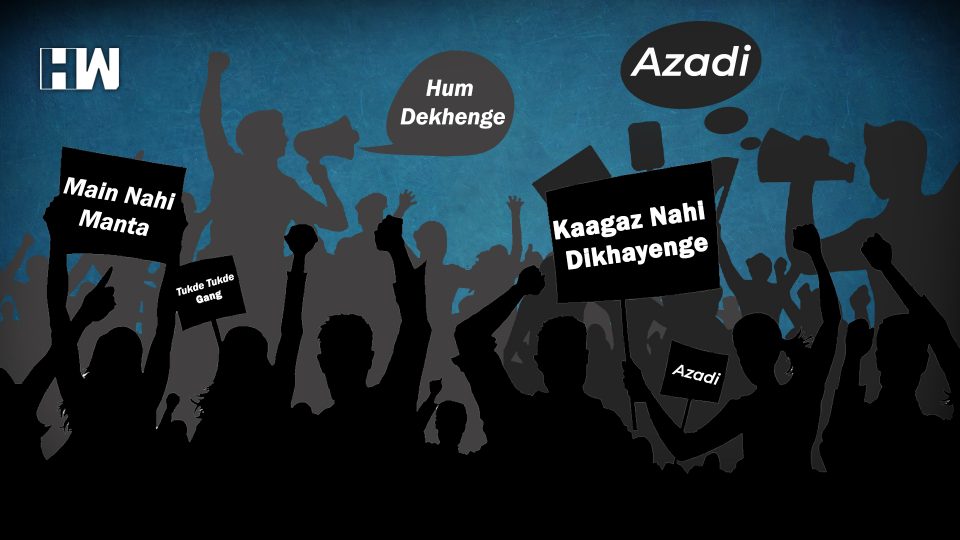Catchy protest banners and street paintings outside Jamia University, Anti-CAA & NRC protests have witnessed many forms of art.
Art has always been the strongest medium of dissent. From the music of Bob Marley against the oppression to Faiz Ahmed Faiz’s poetry against the dictatorial powers, art has a long history of strengthening dissent.
Anti- CAA & NRC protests have witnessed many forms of art. Catchy protest banners and street paintings outside Jamia University have attracted more shares and likes on social media. But songs and poetry seem to have garnered more attention in the span of the last two months. Here’s a list of songs and poetries that were heard and sung in the nation-wide protests.
Hum Dekhenge by Faiz Ahmed Faiz
This poem was written by revolutionary communist poet Faiz Ahmed Faiz against the dictatorship of Jia-Ul-Haq in Pakistan. The poem fantasises about the day when the oppressive government will be thrown out and people will have their own state. The poem gained attention when the controversy erupted around it in IIT Kanpur. Protesting students sang Hum Dekhenge, resulting into IIT Kanpur forming a committee to decide if the poem was anti-Hindu. That had zero effect on the protestors all around and Hum Dekhnege continues to be a go-to protest song.
IISc students sing Hum Dekhenge:
Hum Kagaz Nahi Dikhayenge
Renowned lyricist and stand-up comic Varun Grover came up with this poem. National Register of Citizenship (NRC) demands the verification of documents of individuals to prove their citizenship. The title of the poem simply translates as We won’t show the documents. The poem has been a major hit and is recited at almost every protest that takes place. People have translated the poem in different languages to increase its reach.
Varun Grover reciting Hum Kagaz Nahi Dikhayenge:
"हम काग़ज़ नहीं दिखाएँगे।"
Inspired by the spirit of every protestor and India-lover. With hat-tips to Rahat Indori saab and the Bangla slogans.
(There is no copyright on these words – feel free to use them, adapt, sing, modify, create.) pic.twitter.com/bJZULAAvR8
— वरुण (@varungrover) December 21, 2019
Tum Kaun Ho Be by Puneet Sharma
Video of Lyricist Puneet Sharma reciting his poem Tum Kaun Ho Be in a protest at Mumbai’s Gateway of India went viral. He was expressing his anguish after the attack of masked goons on JNU students. The poem was an overnight hit when many Bollywood celebrities shared the video. Tum Kaun Ho Be is also used as a slogan in many protests.
Puneet Sharma reciting Tum Kaun Ho Be at Mumbai Protest:
1/5 | @PuneetVuneet ki kavita “Tum Kaun Ho Be” pic.twitter.com/N19gQ5nuEg
— Amrita Rajput (@ummreetaa) January 7, 2020
Tukde Tukde Gang by Madara
This youtube video by rapper Madara garnered eyeballs for its bold lyrics and was an instant hit. Some of the lines of rap target the incumbent government and asks about who the real Tukde Tukde gang is. This video has about 518k views on youtube.
Video on YouTube:
Azadi
The origin of the Azadi slogan is a matter of debate. Many right-wing intellectuals suggest that it has emerged during the insurgency in Jammu & Kashmir. Although, it became mainstream when Kanhaiya Kumar chanted the slogans after his release from Tihar Jail in 2016. The meaning of this slogan is debated since it asks for freedom from a number of traditional and patriarchal concepts. The slogans were made into a song for movie Gully Boy.
Kanhaiya Kumar chanting the Azadi Slogan:
Dastoor by Habib Jalib
Dastoor by Habib Jalib is recited in a number of protests. Habib Jalib was an anti-establishment poet in Pakistan and is known for being jailed by every regime for his open criticism through poetry. Main Nahin Manta, Mai Nahi Janta stands translated as ‘I don’t accept the system that runs this country’.
JNU students singing Dastoor:
As an independent media platform, we do not take advertisements from governments and corporate houses. It is you, our readers, who have supported us on our journey to do honest and unbiased journalism. Please contribute, so that we can continue to do the same in future.

